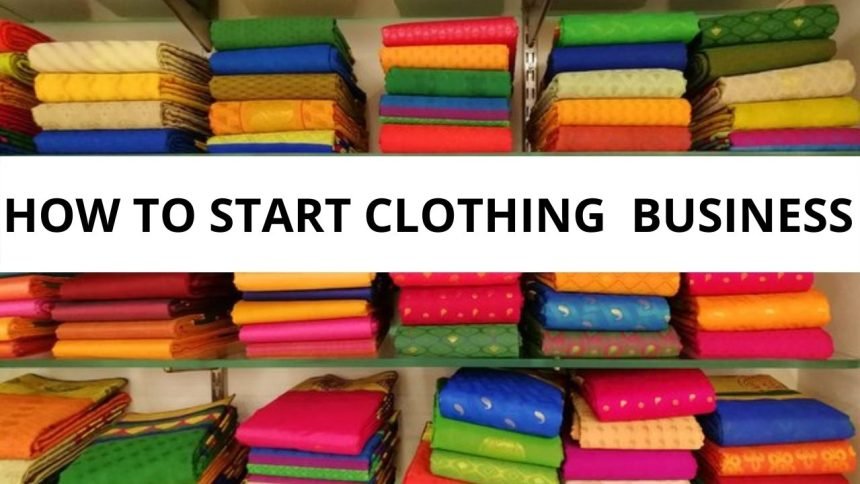How To Start A Clothing Business In India
- How To Start A Clothing Business In India?
- Steps To Start A Clothing Business In India
- Clothing Business In India- How To Get Your Brand Noticed?
- How To Start An Online Clothing Store?
- Conclusion
- FAQs
How To Start A Clothing Business In India
Starting a clothing business in India requires a thorough understanding of the market and a clear strategy. The apparel industry in India is one of the largest in the world and is expected to grow at a CAGR of 8.8% between 2020 and 2025. The Indian market offers opportunities for both traditional and contemporary clothing, with a growing demand for western wear and fusion wear. Readymade garments are a 3 trillion dollars industry and over one trillion clothes are sold worldwide every year.
To start a clothing business in India, it is important to identify the target audience and create a unique brand identity that caters to their needs. Developing a strong business plan that includes sourcing materials, manufacturing, and distribution is crucial. India has a large number of textile manufacturers and suppliers, making it relatively easy to source materials locally.
Setting up a robust supply chain and obtaining necessary licenses and permits is important. Online marketplaces such as Amazon, Flipkart, and Myntra provide a platform for small businesses to reach a wider audience. Building a strong online and offline presence is also essential for the success of a clothing business in India.
Overall, with its vast market, growing demand for clothing, and a supportive ecosystem for small businesses, starting a clothing business in India can be a profitable venture.
Steps To Start A Clothing Business
Step 1: Make A Business Plan
Business Plan for Starting a Clothing Business in India:
-
Market Research: Conduct market research to identify the target audience, competitors, and consumer preferences.
-
Product Range: Develop a unique product line, focusing on quality and affordability, for men, women, and children to meet the demands of the target market.
-
Branding and Promotion: Develop a brand identity and promote the brand through various marketing channels, such as social media, influencer collaborations, and events.
-
E-commerce Website: Establish an e-commerce website to enable customers to shop online and provide an easy and seamless shopping experience.
-
Physical Store: Establish a physical store in a high foot traffic area to cater to customers who prefer in-person shopping.
-
Inventory Management: Implement an efficient inventory management system to ensure adequate stock levels and minimize wastage.
-
Supply Chain Management: Establish a strong supply chain network to ensure timely delivery of products and minimize costs.
-
Human Resource Management: Hire skilled and motivated employees and provide them with appropriate training and resources to ensure optimal performance.
-
Financial Management: Develop a comprehensive financial plan to manage costs, allocate resources, and ensure profitability.
-
Customer Service: Provide excellent customer service to build customer loyalty and increase sales through positive word-of-mouth.
Step 2 : Location
-
Demographics: Look for a location with a target market that matches the type of clothing you offer.
-
Foot Traffic: Choose a location with high foot traffic, such as a mall or a busy street, to increase visibility and attract more customers.
-
Accessibility: Make sure the location is easily accessible by public transportation and has ample parking facilities.
-
Competitors: Research the competition in the area and choose a location with a healthy mix of complementary businesses.
-
Rent: Consider the cost of rent and negotiate favorable terms to ensure profitability.
-
Infrastructure: Ensure the location has good infrastructure, such as reliable electricity, water, and internet connectivity, to support your business operations.
-
Safety: Choose a location with a low crime rate and good security measures to ensure the safety of employees and customers.
Step 3: Market Research
Market research is essential for understanding the clothing industry and identifying the target market. Here are some key areas to focus on when conducting market research:
-
Demographics: Identify the age, gender, income, and lifestyle preferences of your target audience.
-
Competitors: Analyze the products, prices, and marketing strategies of your competitors to identify gaps in the market.
-
Trends: Stay up-to-date with the latest fashion trends and consumer preferences to create a product line that meets the demand.
-
Price Points: Determine the acceptable price range for your target audience based on their income and lifestyle.
-
Distribution Channels: Identify the most effective distribution channels for reaching your target audience, such as e-commerce, physical stores, or both.
-
Brand Perception: Understand how your target audience perceives your brand and develop a unique brand identity that appeals to them.
-
Feedback: Collect feedback from potential customers through surveys, focus groups, and social media to improve your products and marketing strategies.
Step 4: Style Selection
Style selection is a critical aspect of starting a clothing business in India. Here are some key factors to consider when selecting the style of clothing to offer:
-
Target Audience: Identify the age, gender, income, and lifestyle preferences of your target audience to create a product line that meets their needs.
-
Fashion Trends: Stay up-to-date with the latest fashion trends and consumer preferences to create a product line that is in demand.
-
Cultural Appropriateness: Take into account the cultural norms and preferences of the region in which you plan to operate and tailor your product line accordingly.
-
Comfort and Functionality: Ensure that the clothing you offer is comfortable and functional, as well as fashionable.
-
Seasonal Variations: Offer clothing that is appropriate for the different seasons in India, such as lightweight and breathable fabrics for summers and warmer clothing for winters.
-
Quality and Affordability: Focus on providing high-quality clothing at affordable prices to attract and retain customers.
-
Brand Identity: Develop a unique brand identity that reflects your style selection and appeals to your target audience.
Step 5: Market Strategy
-
E-commerce Presence: Establish an e-commerce website to reach customers across India and offer a seamless online shopping experience.
-
Physical Stores: Open physical stores in high foot traffic areas to attract customers who prefer in-person shopping.
-
Social Media Marketing: Leverage social media platforms such as Instagram, Facebook, and Twitter to promote your brand, engage with customers, and drive sales.
-
Influencer Collaborations: Partner with influencers to reach a wider audience and increase brand awareness.
-
Events and Promotions: Host events and promotions to create buzz around your brand and attract customers.
-
Customer Loyalty Programs: Implement customer loyalty programs to build a loyal customer base and increase repeat purchases.
-
Customer Service: Provide excellent customer service to create a positive reputation and increase customer retention.
-
Expansion Plans: Develop a plan to expand your business in other cities or regions to increase market reach and revenue.
Step 6: Financing
Financing is an essential component of starting a clothing business in India. Here are some financing options to consider:
-
Personal Savings: Use personal savings to fund the business startup costs, including rent, inventory, and marketing expenses.
-
Loans: Apply for a small business loan from a bank or financial institution to cover startup and operating expenses.
-
Crowdfunding: Raise funds for your business through crowdfunding platforms, such as Kickstarter or Indiegogo.
-
Angel Investors: Seek funding from angel investors who are interested in investing in your business.
-
Venture Capitalists: Pitch your business idea to venture capitalists who can provide funding in exchange for a stake in the business.
-
Government Grants: Apply for government grants and subsidies for small businesses in the fashion industry.
-
Friends and Family: Consider borrowing from friends and family who are willing to invest in your business.
Step 7: Technology
Technology plays a significant role in the success of a clothing business in India. Here are some ways technology can be used to start and grow a clothing business:
-
E-commerce Platforms: Use e-commerce platforms such as Shopify, WooCommerce, or Magento to set up an online store and reach customers across India.
-
Inventory Management Software: Implement inventory management software to track inventory levels, sales, and reorder points.
-
Point-of-Sale Systems: Use a point-of-sale system to manage sales transactions, process payments, and generate sales reports.
-
Digital Marketing Tools: Leverage digital marketing tools such as email marketing, social media advertising, and search engine optimization to reach and engage with customers.
-
CAD Software: Use computer-aided design (CAD) software to create and visualize clothing designs before production.
-
Production Management Software: Implement production management software to track the production process, monitor quality control, and manage supply chain logistics.
-
Wearable Technology: Explore the use of wearable technology, such as smart clothing, to create innovative and functional clothing designs that appeal to tech-savvy consumers.
Step 8: Sourcing
Sourcing is a crucial aspect of starting a clothing business in India. Here are some factors to consider when sourcing materials and production:
-
Suppliers: Identify and establish relationships with reliable suppliers for fabrics, trims, and other materials required for production.
-
Quality Control: Ensure that suppliers provide high-quality materials and maintain consistent quality standards throughout the production process.
-
Sustainability: Consider sourcing materials from sustainable and environmentally responsible suppliers to align with consumer demand for eco-friendly products.
-
Cost: Evaluate the cost of materials and production to ensure that they align with the pricing strategy of the business.
-
Production Capacity: Choose a production partner who can meet the required production capacity and turnaround times.
-
Labor Laws: Ensure that the production partner complies with local labor laws and ethical labor practices.
-
Transportation: Factor in transportation costs and logistics when sourcing materials and products, especially if the production partner is located in a different region.
-
Local Sourcing: Consider sourcing materials and production locally to support the Indian economy and reduce transportation costs.
Clothing Business In India – How To Get Your Brand Noticed
Getting your clothing brand noticed requires a combination of marketing efforts, networking, and unique branding strategies. Here are some effective ways to get your clothing brand noticed:
-
Social Media Marketing: Leverage social media platforms such as Instagram, Facebook, and TikTok to promote your brand, engage with customers, and build a loyal following.
-
Influencer Collaborations: Partner with influencers who align with your brand values and have a similar target audience to promote your products and increase brand awareness.
-
Networking: Attend fashion events, trade shows, and industry conferences to network with other professionals and gain exposure for your brand.
-
Collaborations: Collaborate with other brands or designers to create limited edition collections that appeal to a wider audience.
-
Brand Ambassadors: Hire brand ambassadors who embody your brand’s personality and values to represent your brand and spread the word about your products.
-
Guerrilla Marketing: Use unconventional marketing tactics such as street art, flash mobs, or pop-up shops to create buzz around your brand and attract attention.
-
Unique Branding: Develop a unique brand identity, including logos, packaging, and marketing materials, that differentiates your brand from competitors and resonates with your target audience.















